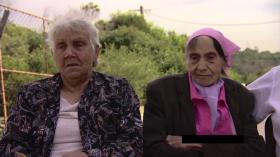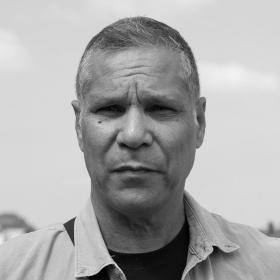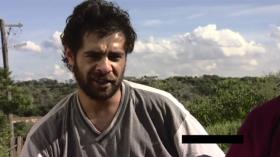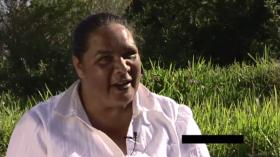Food and culture (audio transcript)
Eight Days in Kamay Exhibition
Return to all exhibition audio transcripts

Aunties Jean Stewart (nee Simms) and Norma Simms, land rights activists and Gweagal Bidjigal historians and senior knowledge holders:
Jean: Well, we lived on fish, I think. Fish was good in those days. You could have it for breakfast and dinner. You could go around and get some mutton fish, around the rocks, around to Congy [Congwong], around the other beaches there, where you could get some mutton fish and take them home and bash them around, and belt them around to soften them up .. they used to share, yes. If they got a load, they’d say, ‘You want any? OK, take some’.
Norma: The fish was plentiful. Uncle Dooka Timbery, that used to do the fishing, he had his little boat, and he used to do the nets. He'd take his net and you knew how to fish then and take the net around and the lookout up the top, there's a lookout up the top – I always called it the lookout because I used to see them there when I was only a girl, you know. They'd all stand up there when the bad weather had come, the wind and rain, and they'd stand on the top and Uncle Dooka and Bobby Dark, Uncle Dooka's son, and Newbert Timbery, they're the ones that done the fishing too. And they'd sing out to the fellow that was in the boat, waiting with the net.
Jean: They'd blow the whistle.
Norma: Yeah. And they'd sing out, tell 'em where the fish was coming in, you know. And then they'd go round and all. And everyone would be down there, helping to pull the net in. And after that fishing, any fishing that went on down there, we’d all have a feed of mullet, or whatever was in that net.That’s how we lived.
From Kamay Botany Bay Oral History Project 2007, reproduced with permission of Kim & Yvonne Simms, Sandra Moffitt and the NSW National Parks and Wildlife Service
Joanne Timbery, Wallangang (now) Elder:
Well I can remember going down to the beach after school, when I’d come home from high school and primary school, and I’d see Uncle Mervyn Cooley there and Uncle Gordon Ella and they’d bring all the fish and that in and they’d give all of us a feed to take home for our family. We used to all go down there, everyone from the mission there, all the kids, and we’d go down there and we’d get a feed, even the white kids, our mates and that, they’d go there and they’d get a feed. Everyone would get a feed to take home for their house. And everyone’d be cooking their feed up. And it would be just a happy time. Everyone’d be merry, and they’d be just all on a high. And we’d be only going there to get a feed for the fish to bring home to our house and I tell you, that was a really really good time.
From Kamay Botany Bay Oral History Project 2007, reproduced with permission of Joanne Timbery and the NSW National Parks and Wildlife Service

Shayne Williams, senior Gweagal clan knowledge holder:
So abalone, we call it mutton fish, and we actually live on those things, you know, from here all the way down to the Victorian border. It’s a real delicacy, you know? It's a delicacy just as the mutton bird might be a delicacy down in Tasmania; it's the same thing for us, we absolutely love them. And that's one of first things we teach the kids to catch when they're young, take them mutton fish diving.
All us kids learned together. So when we was young, you know, seven or eight years old, we would just all go together down the beach and stay there till night. Our parents didn't even worry about us. So round here’s a very, very safe place, you know, there's no rips or anything like that. And we all took care of each other.
If, when I learned to swim it was over the La Perouse side there, I stepped off the rocks and went straight down, and there was always someone there to pull me back up, you know? We was always watching each other. And when we used to swim on that beach over there, there’d always be an adult on the hill sitting there watching, and when they’d go someone else would come, they’d sit there and watch. So we was always being watched by people throughout the community itself.
Recorded for Eight Days in Kamay project, State Library of NSW, 2020. Reproduced with permission of Dr Shayne Williams

Glen Timbery, Wallangang (now) Elder:
A lot of the foods in the area, they’re still there. There’s a lot of fish still there, the oysters, like dad was saying, there’s still a lot of resources out around Botany Bay. Even though there’s big ships coming in every 10 minutes, planes coming over every three minutes, there’s still a lot there for the fishing, the salt water, the mangroves and even in parts of the land.
From Kamay Botany Bay Oral History Project 2007, reproduced with permission of Glen Timbery and the NSW National Parks and Wildlife Service

Shayne Williams, senior Gweagal clan knowledge holder:
We have all different kinds of fish species in here as well, so the generic name for a fish is ‘tahn’, and we have a fish called flathead, which we call ‘dagalang’, and whiting we call ‘warrabugan’, bream we call ‘barri’. You have sharks in here as well, we call them ‘unga’.
April’s the best time for the big sea mullet, they come in from big schools. What they do in April is they leave the lakes down south, but they need rain (bunna) to flush them out, and you need a particular wind, the westerly wind to force them out. ‘Gurra gamarr’ we call it, the westerly wind. So when you've got rain and the westerly wind working together, the fish come out of the lakes and they travel north. And they usually come into Botany Bay, or Kamay, we call it.
You need both; you need rain and wind, and a slight southerly as well. The westerly wind’s the main one, it forces them out, and the rain, and then if you've got a slight southerly wind then it forces them north. So when Cook came here in April, see, that's mullet season.
Recorded for Eight Days in Kamay project, State Library of NSW, 2020. Reproduced with permission of Dr Shayne Williams

Glen Timbery, Wallangang (now) Elder
There’s still some fish there, like the other day there was – baitfish came into the shore and mackerel come in chasing them. It was coming right up to this deep of water so ... Like, this deep. And the mackerel were chasing the baitfish so there's still fish coming through there.
Whales have always been sort of coming up and down the coast, going up to the north, warm waters, migrating but there's always been stories of the whale coming in through the bay. Even down like, it's even in the old cultural stories too, about the whale travelling up and down the coast. The killer whales of the far South Coast, how they used to hunt with the people and there's a lot of stories, a lot of significance with the actual whale itself so when we dance. We pulled out some photos of the old dance group that used to be in La Perouse and the only way we could see, find out what kind of markings that our people wore was from the old photos, and when we pulled the photos out they had the whale bones on.
So the markings that we wear now when we dance and we do corroboree, we wear the whale bones, the actual bones, on the body.
The dancing side of it, wherever they had dances, like inland Aboriginal people got dances of kangaroo and things like that, whereas our people had the dance of the whale. There are stories of them doing the stamping of the feet to call the whale in to bring the fish, you know. The sea life's always been there, whether it was from the whale, to the shark, the dolphin. Djunga – octopus – and the fish, you know. Our people are saltwater people. We live off the sea.
From Kamay Botany Bay Oral History Project 2007, reproduced with permission of Glen Timbery and the NSW National Parks and Wildlife Service

Shayne Williams, senior Gweagal clan knowledge holder:
So when we see whales or starfish or koalas, you know, or this particular little crane, we see human characteristics in them. We don't just see them as mammals or birds or a crustacean or whatever it is; we see human characteristics in those. That's why we have such powerful spiritual bondages now with those particular life forms because they was once humans before they’d taken on their current form.
The women were actually the best fisherpersons as well, you know? That's why there were so many of them in their canoes. And the men, yeah, they would use spears. But the ladies, you know what they would do? They would go out in the canoe and throw a bit of burley over the side and when the fish come up to get the burley they were hit on the head with it, a stick, knock them.
They was also good at catching crayfish as well, we call them ‘yanga’, so the crayfish and lobsters are yanga for us. What they would do, they would get a stick and go up to one of the creeks and put a bit of meat on the end and just hold it in the water and when the crayfish would grab it they would just lift it out. So they would spend a lot of time catching crayfish like that as well.
Recorded for Eight Days in Kamay project, State Library of NSW, 2020. Reproduced with permission of Dr Shayne Williams

Shayne Williams, senior Gweagal knowledge holder:
When you're sitting on the hills it's just like sitting at a school, hey, they just teach you all these things, they teach you what to look for. They teach you how to read the climate, you know?
And one day we was on this hill looking down at the water, he said look at that whiting down there, and I looked and I couldn't see nothing. I was looking in the water, he said no, look on the sand, he said, you'll see it's shadow moving. Anyway, I looked down and I could see this shadow of a fish. I couldn't see the fish itself, but I could see its shadow going like that.
And then we was looking out in the water one day and he says, oh, look at them fish out there, and I was looking, I couldn't see nothing. He said, no, you look for the flash. Because when they roll on their side the sun hits their scale and they go flash in the water.
Oh, people moved all the time, but, see, around here, if you look at that bay there, that's like one big refrigerator. So we really didn't have to go very far, you know? You've got bitha on the rock there, that's oysters see them there, then you've got plenty of those.
In fact, when Cook was over at Towra, just about two ks from here, they came across these big massive oyster shells and the oysters, and he said they was the biggest oysters he’d ever seen, and this was after he’s come across from the Pacific.
So if you go over to Towra you'll still find those big shells.
Recorded for Eight Days in Kamay project, State Library of NSW, 2020. Reproduced with permission of Dr Shayne Williams

Glen Timbery, Wallangang (now) Elder:
It’s been a tradition for over 200 years, before the Europeans landed, and it's been passed down through ... through the name passed down from father to son ever since and it's important for me to learn and to pass it on again so the knowledge stays.
The culture and every aspect of the culture I think is very important to be handed down, especially in this area here because this is where it first got hit. That's important, that's another important thing because this was the place, Botany Bay was the place. La Perouse and the people of La Perouse provided not only for a lot of Aboriginal people but for a lot of non-Aboriginal people. And that is through by providing seafood and things like that, tucker and knowledge of the land and sea and the land itself, building houses on it, stay here, stay there, you know, and, you know, Aboriginal people provided for a lot of people for a lot of years.
From Kamay Botany Bay Oral History Project 2007, reproduced with permission of Glen Timbery and the NSW National Parks and Wildlife Service

Joanne Timbery, Wallangang (now) Elder:
There’s still a lot of bush tucker there , and the bush medicines there, there’s a lot there.
It’s so lovely and peaceful over there, you know. It’s quiet. Well, it’s like a spiritual thing, you know, putting back the native plants when you rip all the lantana and things out. But just being there at Kurnell, it’s got that special feeling. Cause I know with the Kooris and that there too, I know it’s got it’s white history but you can still feel that Koori spirit in that place there at Kurnell. I just love it. I love working there.
From Kamay Botany Bay Oral History Project 2007, reproduced with permission of Joanne Timbery and the NSW National Parks and Wildlife Service